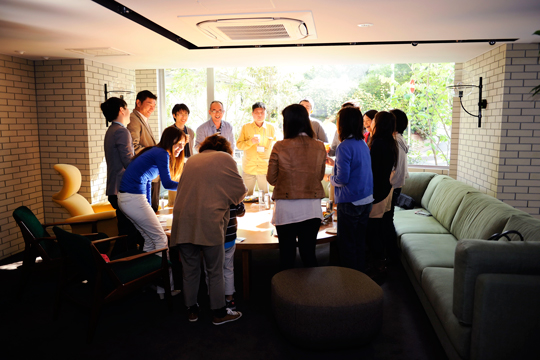
How much do you know about your neighbors? A lot? Not much? Or absolutely nothing?
Now a days, we have convenient tools to connect people anywhere in the world. These things make it easier to connect people further away from you, than the people next to you.
In light of this trend, Masafumi Ara, who organizes “HITOTOWA INC.” proposes ‘neighborhood design.’ His projects aim to enrich the life by building communities and create relationships of mutual trust in an apartment building or a local community.
Open for a wide range of people: A-standard
Here, I would like to introduce a major example of what HITOTOWA INC. does. It is a project organized at the apartment buildings, named “A-standard.”

For this project, Ara planned to make apartment buildings in Hongo-3cho-me and Sakuragaoka which is quite different from other apartments. As Ara points out,
This building assists in creating opportunities to be a good neighbor.
Ara compares with several housing concepts.
In previous apartment buildings, there were clear themes like “eco” or child care, so it was easy to make a community because people had the similar values.
However, there are a wide range of people in A-standard, and it’s up to the people how much they wish to relate to the community.
Of course, the preference of relationships is different depending on the people. We can hardly find out anything about the balance until we communicate with each other.

Ara communicates with inhabitants.
Ara says that people can find their common problems and solutions for them by communicating with each inhabitant, and such process would enrich their activities in their community.
Considering this, A-standard may be the first apartment building to attempt to develop a unique community. I feel that inhabitants in A-standard motivate to join events.
We can see the ingenious device in A-standard. There is a town map displayed in the common space. Residents can share the information on this map. For example, one man introduces his favorite Chinese restaurant and says “my recommendation is their “Mapo Doufu.” This map certainly creates a chance for the residents to talk to others.

During the design phase, what kind of the community does Ara imagine?
Our image of “community” has changed in step with the times. Long ago, community was seen as a restraint. However, when people eliminated their restraints, they felt lonely.
If we can offer an environment helps people to realize such a concept for apartment buildings and local areas, we may solve social problems. But it is difficult for private companies.
HITOTOWA INC. aims to play this role and contribute to the society.
Stroll down to our town!
In the past, there hadn’t been a chance for local to introduce the good points of their neighborhoods to newcomers. Then, in A-standard at Hongo, a social gathering took place.

In this way, taking the time, people will come to have an attachment to their town and community, and then they will have a new home. So, this event was well received by both long-term residents and newcomers.

Today, ways of living have became more diverse. How do we know that communities will develop in the future?
Community is composed of people who are in the same generation and have the same values. If this style is a local community 1.0, local community 2.0 and 3.0 should be developed by including many generations and diverse backgrounds.

In such circumstances, how will be able to neighborhood design change in the future?
It will become a very generation-mixed community. And then, by gathering a variety of people, there will be a lot of problems and values.
We each find our needs and make a place for the inhabitants can share. Through this process, I hope that everyone can find new neighborhood design, and it is linked to local community 2.0, 3.0!
The more the people in the community become diverse, the more positive possibilities in the community we will get. Though we still have many problems because of people’s diversity, we also have many solutions for the same reason.
A nearby friend is preferable to a far-dwelling kinsman. Why don’t you join a local community?
[via Greenz.jp written by Masami Yamamoto]
[English Text by Kanna Yoshida]
NEXT ACTION
What is an ecosystem of a community? Here’s how Ryuta Aoki thinks
http://greenzglobal.jp/gdtokyo_aoki-5153.html

